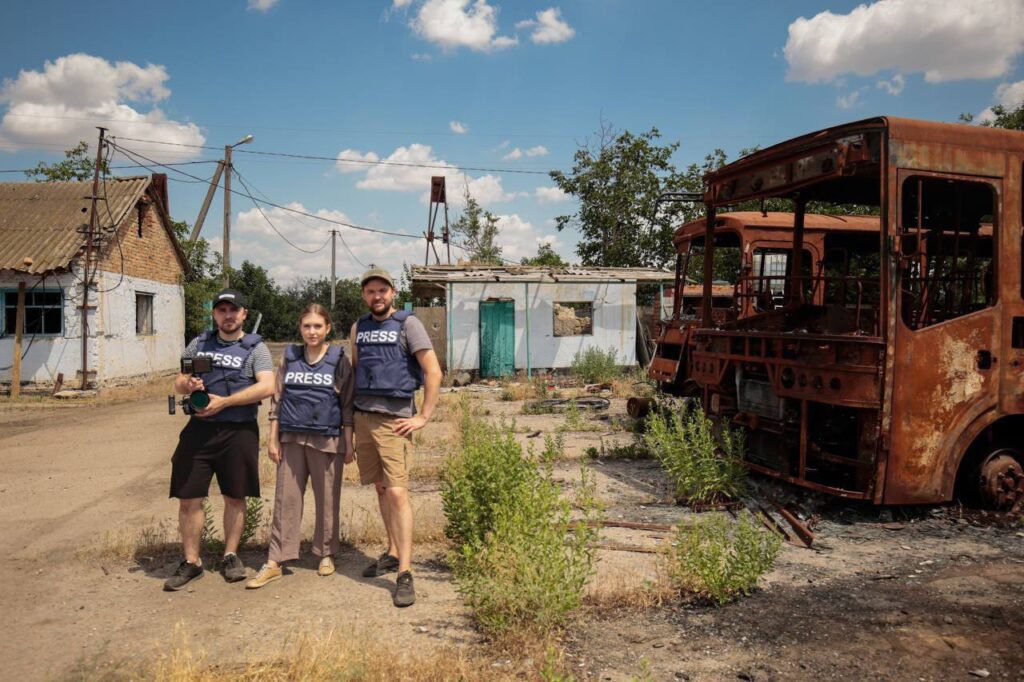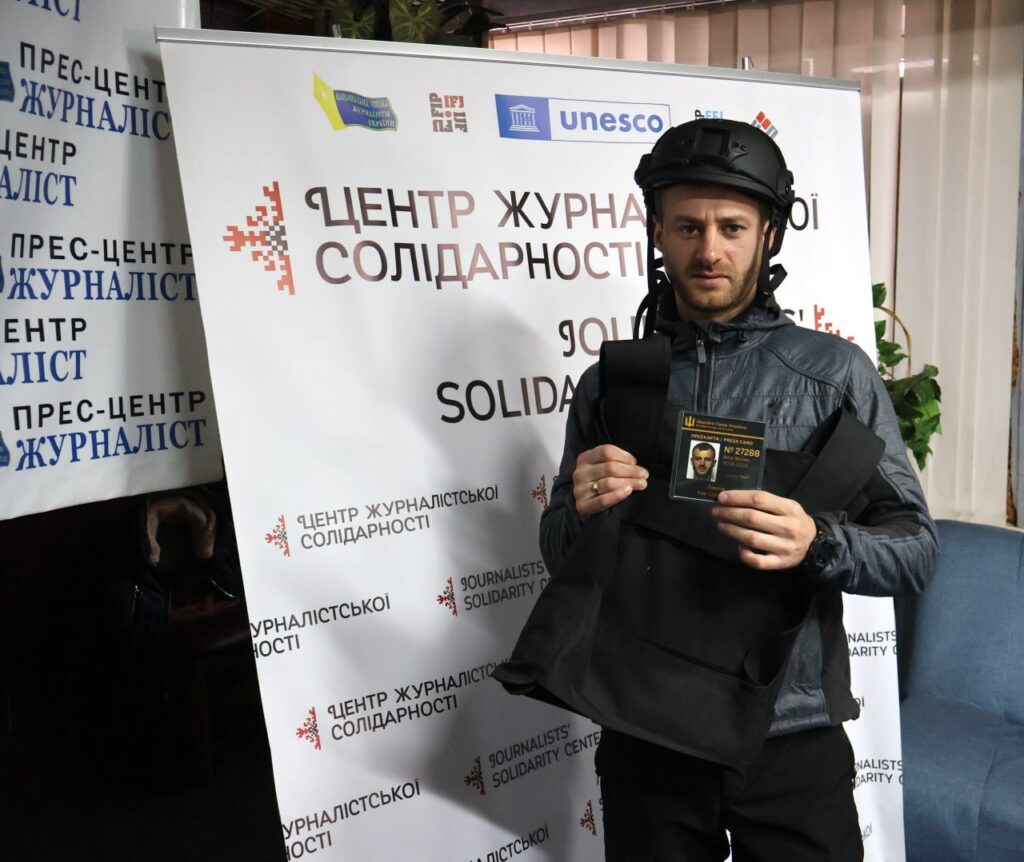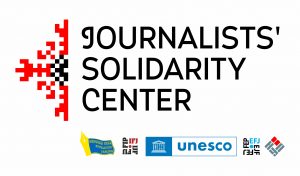Dmytro Sanin, a cameraman from Kyiv, recalls filming the evacuation from Irpin and Bucha in the early days of the full-scale invasion without a bulletproof vest. Iryna Staroselets, a journalist from the Ukrinform news agency, shares her experiences reporting from the Kherson Region, equipped with protective gear from the Kyiv Journalists’ Solidarity Center. Polish photojournalist Sebastian Płocharski, who has been covering the war in Ukraine for nine years, describes his trips to the front-line town of Niu York as “jumping into hell.”
These stories are just a glimpse into the hundreds that highlight the crucial role of the Journalists’ Solidarity Centers. Currently, six such Centers operate across Ukraine – in Kyiv, Lviv (with a presence in Chernivtsi), Ivano-Frankivsk, Kharkiv, Zaporizhzhia, and Dnipro. They provide journalists not only with protective equipment but also with essential support and expert consultations.
Since the beginning of the full-scale invasion, hundreds of Ukrainian and foreign journalists have received bulletproof vests, helmets, and first-aid kits from these Centers. The beneficiaries include both those working directly on the front lines and those covering life in cities close to combat zones.
Each account is a testament to the courage and dedication of these professionals. Ihor Lavrov, a photographer from Zaporizhzhia, once captured the beauty of Khortytsia Island but now documents the destruction of war and the heroism of defenders. Ihor Pylypenko, a fixer for Swedish television, has traversed almost the entire front line. These and other stories underscore the critical importance of supporting journalists in their dangerous but essential work.
As the conflict persists, the Journalists’ Solidarity Centers stand as beacons of safety and support for those committed to bringing the truth to the world, regardless of the risks involved.

From a theater helmet to professional protection: the path of a Ukrainian military cameraman
Dmytro Sanin, a cinematographer from Kyiv, recalls the first days of the full-scale invasion as a time of complete chaos and unpreparedness. “We all found ourselves on the front line without any experience of war journalism,” he says about the events of the beginning of 2022.

While working on documentary footage of the evacuation from Irpin and Bucha for an American company, Dmytro faced a shocking reality: “They believed that I should take care of my own protection. Can you imagine? I risked my life, and they didn’t even think about my safety.”
The contrast with foreign colleagues was striking. “They had everything: equipment, body armor, legal support, insurance. And I… I had nothing. No protection, no first-aid kit, even the accreditation was expired,” Sanin recalls.
The experience of working in the hot spots of Africa and my instinct of self-preservation helped me to survive. “Friends from the theater lent me the helmet. It was more difficult with the bulletproof vest. My colleagues and I held a daily ‘callback lottery,’ looking for someone to borrow protective equipment from,” says the operator.
The situation changed only at the beginning of April when Dmytro received a bulletproof vest from the National Union of Journalists of Ukraine. “When I first put on this ‘plate carrier’ with the inscription PRESS, I felt not only physical but also moral protection. Finally, I could focus on work and not on survival,” Sanin concludes.
Security Above All: International Support for Journalists in Conditions of War in Ukraine
The international community quickly responded to the needs of Ukrainian journalists in protective equipment with the beginning of the full-scale invasion. In April 2022, a landmark event took place in Lviv. During an official ceremony attended by representatives of UNESCO, NUJU, and Reporters Without Borders, 25 sets of protective equipment were handed over to Ukrainian media workers.

This event was only the beginning of further large-scale support. UNESCO headquarters later provided 100 more bulletproof vests and helmets for journalists working on the front line. In total, thanks to various international partners (the largest contributions were made by UNESCO headquarters and the German government), the NUJU received 300 bulletproof vests, which were given to newsrooms and front-line reporters for permanent use.
During the ceremony in Lviv, the President of the NUJU, Sergiy Tomilenko, emphasized: “In these difficult days, all journalists unite for mutual assistance. Our international partners do not stand aside from the problems of Ukrainian media workers and try in every way to provide practical assistance. Centers of journalistic solidarity are a desire to effectively help colleagues.”
The Secretary General of the International Federation of Journalists, Anthony Bellanger, emphasizes the importance of international solidarity: “Journalists are at the forefront of exposing the real human consequences of this barbaric war against Ukraine. The IFJ is proud to have the opportunity to work with the NUJU in creating vital Centers for practical solidarity with journalists – from security to professional support.”
Currently, part of the received protective equipment is provided for free rental through the network of Journalists’ Solidarity Centers. This allows providing many journalists with the necessary protection, especially, that touches those who work in the most dangerous conflict zones.
NUJU is looking for options to upgrade protective equipment
At the same time, the war in Ukraine continues, and the need for protective equipment for journalists remains acute. Equipment that is actively used in hazardous environments naturally wears out and needs to be replaced. The NUJU is reporting an increasing number of requests from the media for helmet and bulletproof vest upgrades.

“We receive more and more requests from journalists who need replacement of protective equipment or new sets for permanent use,” says the President of the NUJU, Sergiy Tomilenko. “This shows not only the intensity of work of our colleagues in dangerous areas but also the need to constantly update and expand our support program.”

The situation emphasizes the importance of continued international support for Ukrainian journalists. The NUJU is actively working on finding new partners and funding sources to provide media workers with high-quality and modern protective equipment. This is critically important for the safety of those who risk their lives every day, covering the realities of the war in Ukraine.
Journalists highly appreciate the quality and availability of protective equipment
In view of the large number of media workers in need of protective equipment and the irregularity of their trips to dangerous areas, the NUJU has implemented an effective system for the distribution of protective equipment. Body armor and helmets are placed at Journalists’ Solidarity Centers across the country, where journalists can get them for temporary free use – a scheme that has been successfully operating since 2022.
Each Center offers high-quality body armor with the inscription PRESS, equipped with certified plates of Protection Class 4, helmets, and tactical first-aid kits. This equipment is available to both Ukrainian and foreign journalists for business trips to the front-line zones.

Iryna Staroselets, a Ukrinform journalist who regularly covers the events in the Kherson Region, highly appreciated the convenience and lightness of the bulletproof vest received at the Kyiv Center. “Compared to the heavy and bulky equipment I used to borrow from other organizations, this is heaven and earth,” she shared. “Without such protection, it would be too risky to work in an area of constant shelling.”

The team of the Lviv TV channel, Pravda Tut, also regularly uses the services of the Western Ukrainian Center. Viktor Sembratovych, the operator of the channel, emphasizes the importance of teamwork in dangerous conditions: “When we are together and well equipped, you feel much more confident. You know that you will not be alone at a critical moment.”
Innovative protection for women journalists
At the end of 2023, Ukrainian journalism took a significant step forward in ensuring the safety of female media workers. The Kyiv Journalists’ Solidarity Center received the first women’s anatomical body armor in Ukraine from the Ukrainian Armor company.
This news was a real breakthrough in solving a long-standing problem. Previously, female journalists had nothing to do but use “universal” body armor, which often created discomfort and restricted movements. Now, thanks to the new design, these inconveniences are in the past.
“This bulletproof vest takes into account the peculiarities of the female anatomy,” explains Yehor Krayevskyi, the head of the support department of Ukrainian armor. “We’ve positioned the body armor pocket so it doesn’t get in the way but provides the same level of protection as the men’s models. Additionally, there are ballistic pouches throughout the body armor for added protection.”


The new bullet-proof vest impresses with its versatility. Without armor plates, it provides second-class protection, capable of stopping debris and bullets from a TT pistol. With installed plates, the level of protection increases to Class 6, which allows withstanding even a shot from a sniper rifle. Collarbones, sides, and back are additionally protected.
In the front-line areas, there are the most requests for bulletproof vests
Journalists’ Solidarity Centers located near the front line – in Dnipro, Zaporizhzhia, and Kharkiv – have become vital hubs for journalists covering events in the war zone. Demand for protective equipment is highest here, underscoring the critical role these Centers play in ensuring the safety of media workers.

Iryna Sytnik, the editor-in-chief of the weekly, Stepova Zoria, and the website Petropavlivka.city, regularly addresses the Dnipro Center. Having the accreditation of the Armed Forces of Ukraine, she often works in the front-line territories of the Donetsk and Zaporizhzhia Regions. Iryna recalls her experience covering a large-scale fire that took place in the Mykolayiv Community:
“Without protective equipment, I simply would not have gotten access there. Even during my work there, explosive devices continued to detonate. The Journalists’ Solidarity Center ensured that I could do my work safely in such extreme conditions.”

Ihor Lavrov, a well-known Zaporizhzhia photo artist, radically changed the focus of his work after the start of the full-scale invasion. From filming the nature of Khortytsia, he moved on to documenting the consequences of the war. The Zaporizhzhia Center not only helped him with accreditation but also provided him with the necessary protective equipment and thermal clothing for work in the cold season.
“The Center not only gave me a helmet, a bulletproof vest, and a first aid kit but also taught me how to use them correctly,” Ihor says. “Their advice on working in the front-line areas is invaluable. They help to overcome fear and focus on work in conditions of constant explosions and shelling.”

Ihor Pylypenko, a Dnipro fixer who has been cooperating with the Swedish broadcaster SVT for two years, emphasizes the convenience of working with the Center:
“We traveled almost the entire front line – from Zaporizhzhia to Sumy. Every month, I take protective equipment from the Dnipro Center. It is much more convenient than looking for it from friends or at the filming location, as I had to do before.”
Extreme conditions test the strength of not only journalists
Polish freelance photojournalist Sebastian Płocharski, who has been covering the war in Ukraine for nine years, knows the value of quality protective equipment. For the second year in a row, he received it at the NUJU’s Dnipro Journalists’ Solidarity Center for his work in the Donetsk Region. Cooperating with such publications as Newsweek Polska, oko.press, Gazeta Wyborcza, as well as creating documentaries for the BBC, Sebastian is constantly in the epicenter of events.

However, even the most reliable equipment does not always withstand the extreme conditions of the front. During a recent trip to Toretsk, Płocharski ‘s helmet attachment system failed. This situation clearly demonstrates how intensively protective equipment is used in the war zone.
“We go to the front line several times a week,” says Sebastian. “Traveling to Niu York is a real ‘jump into hell.’ We drive there quickly, evacuate people, and come back very quickly. Bombs from airplanes, artillery, and kamikaze drones are everywhere all the time.”
In this situation, journalistic solidarity worked. The damaged helmet was transferred to the Kyiv Journalists’ Solidarity Center of the NUJU for a replacement. Sebastian will soon receive a new helmet, and the damaged one will become an exhibit at the NUJU museum, symbolizing the dangerous and stressful work of journalists documenting the crimes of the russian occupiers.
This story emphasizes not only the importance of quality protective equipment but also the need to regularly update it. In this regard, the NUJU actively communicates with partners regarding the need to replenish stocks with new body armor and helmets for journalists working in Ukraine. This is critical to ensure the safety of media workers who risk their lives every day covering events on the front lines.

How to get protective gear
NUJU‘s Journalists’ Solidarity Centers provide Ukrainian and foreign journalists with branded bulletproof vests, helmets, and tactical first-aid kits. If you need to receive protective equipment for free temporary use – fill out this FORM.
How to find Journalists’ Solidarity Centers?
The Centers are always open on weekdays. But it is better to call the coordinators in advance to agree on a convenient time for you. The Centers are located at the following addresses:
- in Kyiv – 27A Khreshchatyk Street, Tel.: 050 680 5204 (Ilya Suzdaliev);
- in Lviv – 5 Solomiyi Krushelnytskoyi Street, 2nd floor; Tel.: 097 907 9702 (Nataliya Voitovych); point of presence in Chernivtsi – 96 Nezalezhnosti Avenue, Tel.: 068 286 3706 (Volodymyr Bober);
- in Ivano-Frankivsk – 25 Sichovykh Striltsiv Street; Tel.: 066 677 07 26 (Viktoriya Plakhta);
- in Zaporizhzhia – 152 Sobornyi Avenue, Tel.: 096 277 5352 (Nataliya Kuzmenko, Valentyna Manzhura);
- in Dnipro – 8 Starokozatska; Tel.: 050 919 8479 (Nataliya Nazarova);
- in Kharkiv – Tel.: 095 421 5477 (Hanna Chernenko).
ABOUT UNESCO
UNESCO is the United Nations Educational, Scientific, and Cultural Organization. It contributes to peace and security by promoting international cooperation in education, sciences, culture, communication, and information. UNESCO promotes knowledge sharing and the free flow of ideas to accelerate mutual understanding. It is the coordinator of the UN Action Plan on the Safety of Journalists and the Issue of Impunity, which aims to create a free and safe environment for journalists and media workers, thus strengthening peace, democracy, and sustainable development worldwide. UNESCO is working closely with its partner organizations in Ukraine to provide support to journalists on the ground.
The designations employed and the presentation of material throughout this digest do not imply the expression of any opinion whatsoever on the part of UNESCO concerning the legal status of any country, territory, city, or area or its authorities or concerning the delimitation of its frontiers or boundaries.
The authors are responsible for the choice and the presentation of the facts contained in this digest and for the opinions expressed therein, which are not necessarily those of UNESCO and do not commit to the organization.
NUJU Information Service

 THE NATIONAL UNION OF
JOURNALISTS OF UKRAINE
THE NATIONAL UNION OF
JOURNALISTS OF UKRAINE
















Discussion about this post